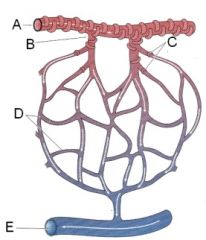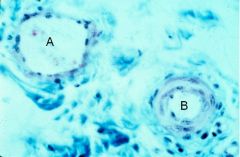![]()
![]()
![]()
Use LEFT and RIGHT arrow keys to navigate between flashcards;
Use UP and DOWN arrow keys to flip the card;
H to show hint;
A reads text to speech;
39 Cards in this Set
- Front
- Back
|
What are the functions of the circulatory system?
|
Pump
Transport Distribute |
|
|
What are the components of the circulatory system?
|
Heart
Arteries Veins Capillaries Lymphatics |
|
|
Characterize arteries and veins in terms of lumen size, wall thickness, wall elasticity
|
Arteries - small lumen, thick elastic walls
Veins - large lumen, thin inelastic walls |
|
|
What are the layers of blood vessels (from innermost to outermost)
|
Tunica intima
Tunica media Tunica adventitia |
|
|
What separates the tunica intima from the tunica media? How 'bout the media from adventitia?
|
Internal elastic lamina
External elastic lamina |
|
|
T or F
The endothelium has a prominent glycocalyx that plays an important role in hemostasis. |
Yup. Certainly is true.
|
|
|
Describe the components of the tunica media in a muscular artery.
|
Smooth muscle cells
Collagen fibers Elastic fibers Fibroblasts |
|
|
What is the name for nerves that innervate vessels? How 'bout the vessels that vascularize vessels?
|
Nervi
Vaso vasorum |
|
|
What is found in the tunica adventitia of blood vessels?
|
external elastic lamina
fibroelastic CT Nervi Vaso vasorum |
|
|
What are the three histological layers of the heart?
|
Endocardium
Myocardium Epicardium |
|
|
What comprises the endocardium?
|
Endothelium and Subendothelium
Subendothelium = collagen/elastic fibers, adipocytes, smooth muscle, BVs, nerves, purkinje fibers |
|
|
What is the tunica intima called in the heart? How 'bout the tunica media? Let's go for three and do the tunica serosa?
|
Endocardium
Myocardium Epicardium |
|
|
What characterizes Purkinje fibers microscopically?
|
Pillowy, less acidophilic, in the endocardium of the ventricle mostly but also atrial
|
|
|
What kind of cell layer is the outermost layer of the visceral pericardium?
|
Mesothelium
|
|
|
What are the functions of the cardiac skeleton?
|
Support
Attachment points for muscle Electrical insulation |
|
|
What are the parts of the cardiac skeleton and where are they located?
|
Annuli fibrosi - around each heart valve
Trigonum fibrosum - connects annuli fibrosi together Septum membranaceum - ventricle septum |
|
|
T or F
Purkinje fibers are modified cardiac nerves that generate and transmit an action potential. |
False, you sucka!
Purkinje fibers are modified CARDIAC MUSCLE CELLS |
|
|
What are two types of receptors in the heart? What is the general function of each?
|
Baroreceptors - detects pressure changes
Chemoreceptors - detects changes in O2/CO2 and pH |
|
|
What are the two types of chemoreceptor cells?
|
Type I - glomus
Type II - sustentacular |
|
|
Where are chemoreceptors found and what nerves are they associated with?
|
Carotid bodies (bifurcation of common carotids) - glossopharyngeal n.
Aortic bodies - on aortic arch btw. subclavian and left common carotid - Vagus n. |
|
|
Where are baroreceptors found? What nerves are associated with each area?
|
Carotid sinus - dilation in internal carotid - glossopharyngeal n.
Aortic sinus - dilation in aorta - vagus n. |
|
|
T or F:
The majority of arteries in the body are muscular arteries. |
Tru dat.
|
|
|
T or F:
The aorta is a muscular artery. |
False fool!
The aorta is an elastic artery! |
|
|
Compare/contrast muscular and elastic arteries.
|
Elastic arteries are larger (larger lumen to wall thickness ratio)
Muscular arteries have a prominent internal and external elastic laminae; elastic arteries don't. Elastic arteries have lots of elastic fibers in the tunica media. |
|
|
What is the diameter of arterioles?
|
<100um
|
|

ID these.
What directly connects A to E and what is its function? |

A - Arteriole
B - Metarteriole C - Precapillary sphincters D - Capillary bed E - Venule Arteriolar-venous anastomosis can allow for capillary bed bypass |
|
|
What cells surround capillaries?
|
Pericytes
|
|
|
Name the two types of capillaries. Which type is most common?
|
Continuous and discontinuous.
Continuous is the most common. |
|
|
What is the lumenal diameter of capillaries?
|
8 - 10 um
|
|
|
What are the types of discontinuous capillaries? Where is each found?
|
Fenestrated - endocrine, pancreas, intestines, kidneys
Sinusoidal - bone marrow, lymphoids, liver, spleen |
|
|
Where do most cells jump-off the circulatory train?
|
Venules
|
|

What type of vessels are A and B?
|

A - Vein
B - Artery (both small) |
|
|
T or F:
The vena cava and hepatic portal vein have no valves. |
True!
Most small/medium sized veins have valves, though. |
|
|
T or F:
All vessels (veins, arteries, and lymphatics) can have valves. |
False!
Lymphatics and veins can have valves but not arteries! |
|
|
How can you tell the difference between lymphatics and veins?
|
Vein valves are thicker.
Lymphatics shouldn't contain RBCs. Lymphatics contain acidophilic material. |
|
|
Where in the body are lymphatics NOT found?
|
CNS
|
|
|
What keeps the lumen of a lymphatic open?
|
Anchoring filaments
|
|
|
What are the two main lymphatic ducts and what body region(s) do they drain?
|
Right lymphatic duct - upper right quadrant
Thoracic duct - abdomen and rest of body |
|
|
Where do the main lymphatic ducts drain?
|
Jxn of internal jugular and subclavian (R for R lymphatic and L for Thoracic).
|

